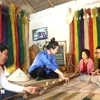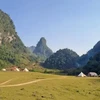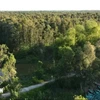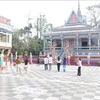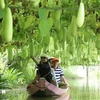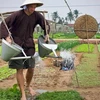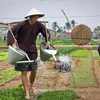Visitors to Sa Pa are enjoying adventure tours in the villages of Ta Giang Phinh in Sa Pa township and Nam Tam in neighbouring Lai Chau Province , where the local people fiercely cling to their traditions.
The tours have become particularly popular in spring, the best season to visit the mountainous area. But Sa Pa is popular from August to April, with foreign tourists flocking to the region.
Ta Giang Phinh is 25km from Sa Pa and is home to the Mong and Dao people. The 3,000m-tall Mt Ngu Chi Son is nearby and the second highest peak in the area, after famed Mt Fansipan.
The village connects with Sa Pa on a narrow road which snakes through the mountains, past native chayote. The mountains and valley of maize and terraced rice fields are seen on sunny days when the clouds clear.
"The village is a very new site that we included among our destinations last year," said Green Sa Pa Tour Co director Dao Van Phong. "We want to introduce an isolated village where the lifestyle has yet to change. People living in the village are always hospitable, and visitors can take break at any house during the two-hour walk around the village."
Phong said his company brought 500 visitors to the village last year.
As the village is nudged in the large Sin Chai Valley , 500m above sea level, tourists can easily find the local Mong people farming the terraced fields or trek through forests of cardamon. Locals often invite visitors with maize and perform the khen (bamboo pan-pipes) dance as they express their hospitality.
The women often stay at home to weave brocade for clothing. With families scattered in isolated spots around the valley and no means of transportation, the only way to get visitors to explore the village is by walking.
"We set up the village to represent the typical lifestyle of the Mong and Dao people," said Green Sa Pa product manager Phung Gia Cao. "Tourists can explore the interesting culture of the Mong and Dao themselves."
Nam Tam Village , in Lai Chau's Binh Lu District, is another hour's drive from Ta Giang Phinh and is in the heart of one of the largest granaries in the northwest of Vietnam . The village of ethnic Lao, Thai and Lu people, with a population of 2,600, sits on a bank of the Nam Mu River on low terrain and amid fertile paddies.
The scenery along the 45km route from Sa Pa to Nam Tam fascinates tourists. On sunny days, clouds dot the blue sky over the mountain ranges.
"Our van often takes many stops along the roadside for tourists to grab a quiet moment on sunny days," said Phong.
As Nam Tam lies along a 20km stretch of the Nam Mu River, rafts are the most popular vehicle for locals to fish or transport rice during the harvest.
"You can easily find a raft on the river as the locals often fish in the daytime," said Phong. "We have already set up a local service, so tourists can board a raft as soon as they arrive in the village. They can paddle themselves along the river and stop at any village along the bank."
Phong said his agency can also arrange rubber rafts instead of bamboo.
After a short stop on the river bank, visitors can mount bicycles for a 20km ride around the area.
"The cycling is a change after a few hours of rafting," said Nguyen Anh Manh, a guide from a Hanoi-based travel agency. "Tourists can stop at several points in the village. They can even leave their bikes and keep walking if they want."
"I've been assigned to take tourists to Sa Pa town for years," Manh added. "Nam Tam and Ta Giang Phinh are actually the best places to stay the night."
Nam Tam Village , which includes three hamlets, is a recognised place to make a homestay. Tourists can spend the night in a hamlet of the Thai ethnic group and view traditional folk dances around a campfire at night. The Thai people hosting the visitors offer grilled fish and meat as the tourists relax after a hard day of rafting and cycling.
"Travellers can dance with the locals, and roast fish over a wood fire for dinner," said Manh. "A night in a stilt house will refresh you for your next day's journey."
Many tourists making a homestay in the village during the Lunar New Year when Thai people flock in with food and wine to celebrate the new year festival./.
The tours have become particularly popular in spring, the best season to visit the mountainous area. But Sa Pa is popular from August to April, with foreign tourists flocking to the region.
Ta Giang Phinh is 25km from Sa Pa and is home to the Mong and Dao people. The 3,000m-tall Mt Ngu Chi Son is nearby and the second highest peak in the area, after famed Mt Fansipan.
The village connects with Sa Pa on a narrow road which snakes through the mountains, past native chayote. The mountains and valley of maize and terraced rice fields are seen on sunny days when the clouds clear.
"The village is a very new site that we included among our destinations last year," said Green Sa Pa Tour Co director Dao Van Phong. "We want to introduce an isolated village where the lifestyle has yet to change. People living in the village are always hospitable, and visitors can take break at any house during the two-hour walk around the village."
Phong said his company brought 500 visitors to the village last year.
As the village is nudged in the large Sin Chai Valley , 500m above sea level, tourists can easily find the local Mong people farming the terraced fields or trek through forests of cardamon. Locals often invite visitors with maize and perform the khen (bamboo pan-pipes) dance as they express their hospitality.
The women often stay at home to weave brocade for clothing. With families scattered in isolated spots around the valley and no means of transportation, the only way to get visitors to explore the village is by walking.
"We set up the village to represent the typical lifestyle of the Mong and Dao people," said Green Sa Pa product manager Phung Gia Cao. "Tourists can explore the interesting culture of the Mong and Dao themselves."
Nam Tam Village , in Lai Chau's Binh Lu District, is another hour's drive from Ta Giang Phinh and is in the heart of one of the largest granaries in the northwest of Vietnam . The village of ethnic Lao, Thai and Lu people, with a population of 2,600, sits on a bank of the Nam Mu River on low terrain and amid fertile paddies.
The scenery along the 45km route from Sa Pa to Nam Tam fascinates tourists. On sunny days, clouds dot the blue sky over the mountain ranges.
"Our van often takes many stops along the roadside for tourists to grab a quiet moment on sunny days," said Phong.
As Nam Tam lies along a 20km stretch of the Nam Mu River, rafts are the most popular vehicle for locals to fish or transport rice during the harvest.
"You can easily find a raft on the river as the locals often fish in the daytime," said Phong. "We have already set up a local service, so tourists can board a raft as soon as they arrive in the village. They can paddle themselves along the river and stop at any village along the bank."
Phong said his agency can also arrange rubber rafts instead of bamboo.
After a short stop on the river bank, visitors can mount bicycles for a 20km ride around the area.
"The cycling is a change after a few hours of rafting," said Nguyen Anh Manh, a guide from a Hanoi-based travel agency. "Tourists can stop at several points in the village. They can even leave their bikes and keep walking if they want."
"I've been assigned to take tourists to Sa Pa town for years," Manh added. "Nam Tam and Ta Giang Phinh are actually the best places to stay the night."
Nam Tam Village , which includes three hamlets, is a recognised place to make a homestay. Tourists can spend the night in a hamlet of the Thai ethnic group and view traditional folk dances around a campfire at night. The Thai people hosting the visitors offer grilled fish and meat as the tourists relax after a hard day of rafting and cycling.
"Travellers can dance with the locals, and roast fish over a wood fire for dinner," said Manh. "A night in a stilt house will refresh you for your next day's journey."
Many tourists making a homestay in the village during the Lunar New Year when Thai people flock in with food and wine to celebrate the new year festival./.

